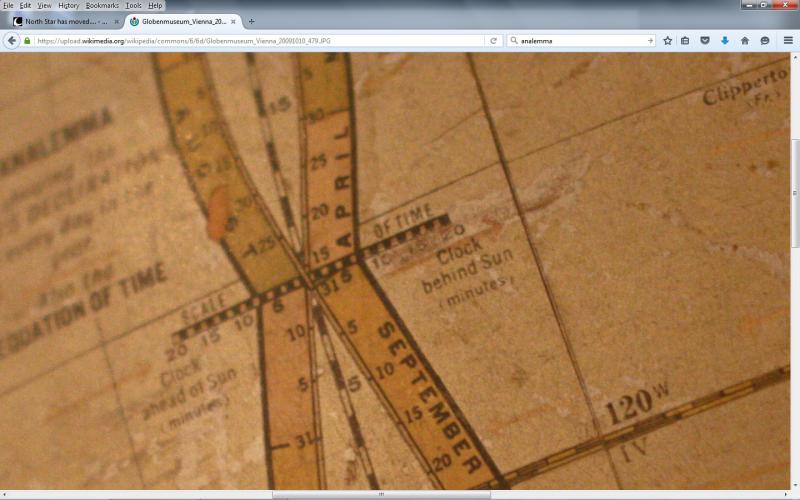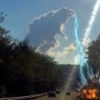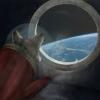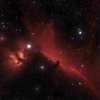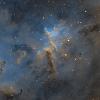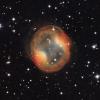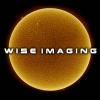I'd confirm the observation, but it's cloudy out.

North Star has moved....
#26

Posted 29 January 2016 - 10:30 AM
#27

Posted 29 January 2016 - 12:26 PM
Absence of OP from the discussion......... ![]()
![]()
![]() -------------->
--------------> ![]() ?
?
Dave
#28

Posted 29 January 2016 - 01:46 PM
Even though the Winter Solstice has the shortest amount of daylight, the earliest sunset, for Toronto's latitude eg. is around Dec 8th. Is this what the OP is referring to when he says " Days mysteriously have more daylight in them than the day before and that's in early winter when days are getting shorter." ?
Because the Earth's orbit is slightly elliptical, the earliest sunset does not coincide with the solstice.
And, unless I am wrong, this is because the major axis of this ellipticity is close to, but not exactly coincident with the Winter solstice axis. The ellipticity axes are slightly rotated "these days" with respect to the equinoxes/solstices axes. I say "these days": our descendants will experience something else... --C.
Ooops... I was wrong. Typing too fast! It's the asymmetry of the analemma that is a result of the ellipticity of the orbit: the top part of the 8 is a different size compared to the bottom part, and the crossing point is not at zero degree inclination, and happens instead April 14th and August 30th approximately: less than 6 months apart! A circular orbit would result in a symmetrical analemma with crossing right in the centre.
From Wikipedia:
"There are three parameters that affect the size and shape of the analemma — obliquity, eccentricity, and the angle between the apse line and the line of solstices. Viewed from an object with a perfectly circular orbit and no axial tilt, the Sun would always appear at the same point in the sky at the same time of day throughout the year and the analemma would be a dot. For an object with a circular orbit but significant axial tilt, the analemma would be a figure of eight with northern and southern lobes equal in size. For an object with an eccentric orbit but no axial tilt, the analemma would be a straight east–west line along the celestial equator."
--Christian
Edited by ChristianG, 29 January 2016 - 01:54 PM.
#29

Posted 29 January 2016 - 01:59 PM
Absence of OP from the discussion.........


-------------->
?
Dave
Maybe a regular user wanting to have a little bit of fun by creating another account?
#30

Posted 29 January 2016 - 03:17 PM
The pointer stars do not point directly at Polaris and never have.
I suspect that the "error" in the pointer stars might be more noticeable at certain angles (seasons) than others. A perceptual problem.
#31

Posted 29 January 2016 - 04:01 PM
I should think a circular orbit with axial tilt should have the analemma describe a straight line running N-S.
That is my thinking as well. The east-west "fatness" of the analemma is caused by our elliptical orbit. (Actually it is cause by the changing speed of Earth, due to its elliptical orbit). If we had a circular orbit, we would also have a constant angular velocity. The sun would not seem to first lag and eventually lead the meridian at noon, and the analemma would be a straight line N-S. Mr. Flanders' post up-thread did not refute this, but did say that even with a circular orbit the earliest sunset / latest sunrise would not occur on the shortest day of the year. But it is too complicated to explain to us. The thing that is being omitted here, I think, is that refraction of the atmosphere at the horizon causes the sun to be "up" for an extra four minutes or so, messing up the picture. So I'm going to say that if we had a circular orbit, and no atmosphere, the earliest sunset / latest sunrise would occur on the shortest day of the year. Oh, and perfectly flat ground. I'm prepared to be shot down here, so have at it!
Steve
Edited to be nicer.
Edited by Steve OK, 29 January 2016 - 04:29 PM.
#32

Posted 29 January 2016 - 04:13 PM
For heavens sake don't let Rodger Ailes hear about this or it will be all over Fox News tonight.
#33

Posted 30 January 2016 - 08:35 AM
I promise I'm not trying to be argumentative here, just trying to understand. These two statements are contradictory:
From post #24: "For an object with an eccentric orbit but no axial tilt, the analemma would be a straight east–west line along the celestial equator."
From post #37: "The E-W "fatness" is actually caused by the Earth's axial tilt, counter-intuitive as it might seem."
The first statement is true, I believe. It then follows that the north-south component of the analemma is caused solely by the Earth's axial tilt.
Shouldn't the second statement (from post #37) say that the axial tilt also contributes to the E-W "fatness"? Why this should be so was not at all apparent to me (or a few others of us!) until this soaked in (from Wikipedia "Equation of Time" link):
However, even if the Earth's orbit were circular, the perceived motion of the Sun along our celestial equator would still not be uniform. This is a consequence of the tilt of the Earth's rotational axis with respect to the plane of its orbit, or equivalently, the tilt of the ecliptic (the path of the Sun seems to take in the celestial sphere) with respect to the celestial equator. The projection of this motion onto our celestial equator, along which "clock time" is measured, is a maximum at the solstices, when the yearly movement of the Sun is parallel to the equator (causing amplification of perceived speed) and yields mainly a change in right ascension. It is a minimum at the equinoxes, when the Sun's apparent motion is more sloped and yields more change in declination, leaving less for the component in right ascension, which is the only component that affects the duration of the solar day.
This is what was missing for me. If we had a circular orbit, the sun would move at a constant rate along the ecliptic. That would not make it move at a constant rate in right ascension, and would thus contribute to the E-W aspect of the analemma.
In fact, the tilt contributes more to the E-W aspect than does the eccentricity of the orbit. That is the part that was hardest to get my head around! There are some animated graphs that show the separate effects, and the combined effects on the Wiki page linked to earlier
https://en.wikipedia...quation_of_time
Thanks for the discussion. This should have been its own thread, rather than evolving from such a strange start.
Steve
edit: So what about that atmospheric refraction? ![]()
Edited by Steve OK, 30 January 2016 - 08:55 AM.
#34

Posted 30 January 2016 - 01:14 PM
Well, to be factual, it is moving, as are we...and not just around the sun.
#35

Posted 30 January 2016 - 02:25 PM
This is a strange thread. Reminds me of the 60's.
Rick if you remember the 60's you weren't doing it right!
#36

Posted 30 January 2016 - 03:32 PM
This morning I went outside and happened to look up and check out the stars...........................................
Hey, if you weren't a brand new member here, I'd cash out my 401k and start partying asap!
#37

Posted 30 January 2016 - 03:35 PM
It's easily proved.
#38

Posted 30 January 2016 - 04:37 PM
This is a strange thread. Reminds me of the 60's.
Rick if you remember the 60's you weren't doing it right!
Well, I still wave my hand around in front of my eyes, does that count?
#39

Posted 30 January 2016 - 05:27 PM
I gave up trying to explain that sunrise/sunset/enema thing years ago! Now I remember why.
#40

Posted 31 January 2016 - 02:32 AM
I gave up trying to explain that sunrise/sunset/enema thing years ago! Now I remember why.
Enemas are a lot easier to explain than the other stuff.
#41

Posted 31 January 2016 - 09:44 AM
Yeah... but I'd rather explain the other stuff...
#42

Posted 31 January 2016 - 10:19 AM
"North Star has moved...."
Hey! That is *exactly* what Khufu's Ka says!
![]()
- Jim
#43

Posted 31 January 2016 - 10:22 AM
Well, to be factual, it is moving, as are we...and not just around the sun.
Polaris is such a chintzy north star anyway, it's about time it moved along.
I remember when I was a kid and Thuban was the pole star. Now that, my friend, was proper north star.
- Jim
#44

Posted 31 January 2016 - 10:25 AM
The pointer stars do not point directly at Polaris and never have.
I suspect that the "error" in the pointer stars might be more noticeable at certain angles (seasons) than others. A perceptual problem.
Or at different blood-alcohol levels.
![]()
- Jim
#45

Posted 31 January 2016 - 10:50 AM
North Star has moved
and so has the OP
#46

Posted 31 January 2016 - 12:53 PM
Kind of like starting a Fire then standing back and watching it Burn.
I hope he is back on his Meds.
#47

Posted 31 January 2016 - 03:05 PM
I'll give the benefit of the doubt to farojak (OP) that he was serious. Since sunset starts getting later in the day in early December, he likely noticed an additional few minutes of daylight in "early winter" prior to the solstice. A few posts detailed reasons for this, but here's a pretty simple-to-understand explanation from the US Naval Observatory why this occurs:
http://aa.usno.navy....s_solstices.php
As for the "movement" of Polaris, I'm guessing Polaris was likely clouded over, and he simply saw a different star. For instance, Kochab (beta UMi) is fairly bright, is in the same general area of the sky and might be confused with Polaris in the early morning sky if Polaris was clouded over. In fact, a few months ago at an outreach event, one of our club members was trying to do a quick polar alignment of his mount and, being in a hurry and not realizing Polaris was under a small cloud, used Kochab to get his "north" bearing. A few minutes later, the cloud moved, Polaris came into view, and he started over.
If the OP was serious, he may be a casual observer and might be unaware the moon rises in different locations with changes of seasons as well as being unaware of the differences between length of days and sunset times. Cloud cover even can disorient seasoned observers making a quick glance at the sky. Give him a break...
#48

Posted 31 January 2016 - 05:46 PM
#49

Posted 31 January 2016 - 05:46 PM
Since sunset starts getting later in the day in early December, he likely noticed an additional few minutes of daylight in "early winter" prior to the solstice.
With respect to sunset times, please read my post #28 in this thread. Sunset times do not begin to change significantly enough to be noticed until Dec. 20..... Sunset times remain within one minute of each other for the three week period prior to the solstice.
I did not look at sunrise times over the same period and the resulting length of daylight when I researched the above data. Moreover I did the research for latitude 44.
I now add latitude 60 and latitude 30 to see how the sunsets go at those latitudes.
For Latitude 60. Earliest sunset occurs Dec 16th (3:09:40). From the 16th to the 20th sunsets get 1.5 minutes later. So, at this northern latitude, it might juuuuuust be possible to notice the later sunsets for a couple of days at most before the solstice. It would still be a subtle change. From Dec 20 to Jan 19 the sunset time moves 46 minutes!!!! Much more noticeable!
For latitude 30: Earliest sunset: Both Dec 2 and 3 (5:16:18). From Dec 3 to the solstice the sunsets get 4 minutes later over a period of 17 days. A bit more noticeable than at higher latitudes but still not a dramatic change. From Dec 20 to Jan 19 the sunsets get 20 minutes later. While more noticeable it is less dramatic change than what occurs at higher latitudes over the same period...
Summary. The further north you are the closer is your 'earliest sunset' day to the solstice. The further north you are the more noticeable the dichotomy between pre-solstice and post-solstice sunset times with the post-solstice sunsets being much more noticeable at all three latitudes...
My somewhat scientific study indicates that it is a myth that sunsets get noticeably later before the solstice at all three latitudes. And that the post-solstice period is when folks really notice the later sunsets.
For fun, later tonight, I will do the same analysis for the equator... Predictions?
Dave
#50

Posted 31 January 2016 - 07:20 PM
I'll give the benefit of the doubt to farojak (OP) that he was serious. Since sunset starts getting later in the day in early December, he likely noticed an additional few minutes of daylight in "early winter" prior to the solstice. A few posts detailed reasons for this, but here's a pretty simple-to-understand explanation from the US Naval Observatory why this occurs:
http://aa.usno.navy....s_solstices.php
As for the "movement" of Polaris, I'm guessing Polaris was likely clouded over, and he simply saw a different star. For instance, Kochab (beta UMi) is fairly bright, is in the same general area of the sky and might be confused with Polaris in the early morning sky if Polaris was clouded over. In fact, a few months ago at an outreach event, one of our club members was trying to do a quick polar alignment of his mount and, being in a hurry and not realizing Polaris was under a small cloud, used Kochab to get his "north" bearing. A few minutes later, the cloud moved, Polaris came into view, and he started over.
If the OP was serious, he may be a casual observer and might be unaware the moon rises in different locations with changes of seasons as well as being unaware of the differences between length of days and sunset times. Cloud cover even can disorient seasoned observers making a quick glance at the sky. Give him a break...
Likewise, I don't think he was trolling. I suspect now he's feeling picked-on. Bad form, really. ![]()
Regards,
Jim







